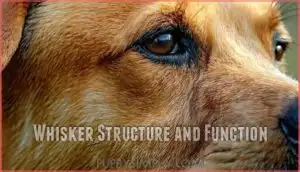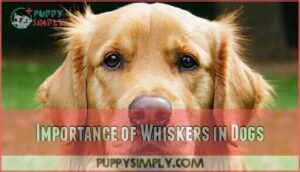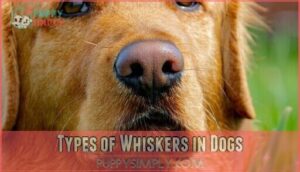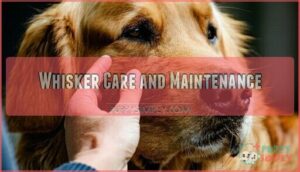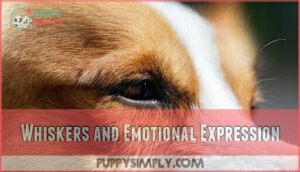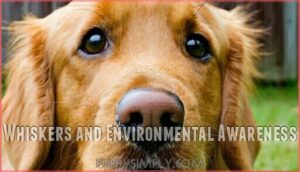This site is supported by our readers. We may earn a commission, at no cost to you, if you purchase through links.
 No, you shouldn’t cut your dog’s whiskers. These specialized hairs aren’t just for show—they’re like your dog’s personal radar system.
No, you shouldn’t cut your dog’s whiskers. These specialized hairs aren’t just for show—they’re like your dog’s personal radar system.
Whiskers help dogs sense their surroundings, navigate tight spaces, and even detect changes in air currents. Without them, your pup might feel a bit disoriented or less confident, kind of like walking blindfolded.
While accidentally trimming one isn’t the end of the world, purposefully cutting them can cause unnecessary stress and confusion for your furry friend. So, it’s best to leave whiskers alone—they’ve got an important job to do!
Curious about whisker growth or care? There’s more to uncover!
Table Of Contents
- Key Takeaways
- Dog Whisker Basics
- Can You Cut Dog Whiskers
- Whisker Cutting Consequences
- Whisker Growth and Regeneration
- Whisker Care and Maintenance
- Whisker Functions and Benefits
- Whisker Health and Veterinary Advice
- Frequently Asked Questions (FAQs)
- What if you accidentally cut dog’s whiskers?
- Does it hurt to cut or trim dogs whiskers?
- Does it hurt dog if their whiskers got accidently cut?
- Are you supposed to cut dogs whiskers?
- Do dogs lose their balance if you cut their whiskers?
- Why is it illegal to cut dog whiskers?
- Is there a purpose to dog whiskers?
- Are dog whiskers sensitive?
- What will happen if I cut my dog’s whiskers?
- Are there any medical conditions related to dog whiskers?
- Conclusion
Key Takeaways
- You shouldn’t cut your dog’s whiskers as they function as essential sensory tools that help your dog navigate spaces, detect air currents, and avoid obstacles.
- If you accidentally cut your dog’s whiskers, don’t panic—they’ll grow back over time, though regrowth rates vary based on your dog’s breed, age, and overall health.
- Cutting whiskers isn’t painful for your dog since the hairs themselves don’t contain nerves, but it can cause disorientation and reduced spatial awareness.
- When grooming your dog, use proper techniques to avoid accidental whisker trimming, such as using clipper guards and being mindful around facial areas.
Dog Whisker Basics
Your dog’s whiskers aren’t just facial decorations; they’re powerful sensory tools that help your pup navigate the world.
Whiskers are your dog’s built-in sensory antennas, guiding them through the world with incredible precision and awareness.
These stiff, specialized hairs are connected to nerves, allowing dogs to detect subtle changes in their surroundings, which makes them a crucial part of their navigation.
Whisker Structure and Function
Dog whiskers, or vibrissae, are thicker and stiffer than regular hair, deeply anchored in follicles rich in nerve endings.
These nerve-packed follicles play a big role in sensory perception, helping your dog navigate the world.
With multiple whisker types—like eyebrow and chin whiskers—their composition and structure make them essential tools for detecting even the slightest air movements, which is truly amazing!
Importance of Whiskers in Dogs
A dog’s whiskers are like nature’s built-in GPS. These fine-tuned sensory tools enhance their spatial awareness, helping them navigate tight spots and detect subtle environmental changes.
Canine whiskers also pick up emotional signals, reflecting their mood, and serve as essential aids in hunting assistance by sensing prey movements.
Their incredible sensory perception makes whiskers essential for a dog’s well-being and confidence.
Types of Whiskers in Dogs
Not all whiskers are the same; each type plays its own role.
Mystacial vibrissae, the iconic whiskers on a dog’s upper lip, act like tiny motion sensors.
Supraorbital whiskers, above the eyes, shield them from debris.
Genal whiskers on cheeks bolster peripheral awareness, while chin vibrissae aid in feeling below.
Mandibular vibrissae extend sensory reach along the jawline, providing a unique function like mystacial vibrissae.
Can You Cut Dog Whiskers

Cutting whiskers might seem harmless, but it’s more than a grooming choice—it’s a sensitive topic with ethical considerations.
Cutting whiskers isn’t just grooming; it disrupts your dog’s sensory world, impacting their awareness and emotional well-being.
Whiskers function as a dog’s sensory antennas, aiding in spatial awareness and navigation.
While trimming dog whiskers isn’t painful, it disrupts their sensitivity, leading to confusion or altered behavior.
Breed differences also play a role, as some dogs rely more heavily on their whiskers.
Imagine walking blindfolded without your hands—that’s how dogs feel if their alternative senses are hindered.
In some places like Germany, there are legal ramifications for trimming whiskers purely for aesthetics.
A key consideration is to avoid cutting whiskers altogether, as they’re essential sensory tools.
Instead of cutting whiskers, focus on proper dog grooming techniques that respect their natural design.
Understanding whisker sensitivity means protecting a critical part of your dog’s life.
Whisker Cutting Consequences
Cutting your dog’s whiskers might seem harmless, but it can lead to confusion and reduced spatial awareness.
These sensitive hairs play a key role in helping your dog navigate and understand their surroundings, which is a complete concept related to their sensory perception.
Effects on Spatial Awareness
Ever tried walking through a dark room without bumping into anything? That’s how trimming dog whiskers affects their spatial awareness.
These sensory tools guide environment navigation, aiding obstacle avoidance and dark adaptation.
Without them, dogs face spatial disorientation and reduced sensory compensation, making navigation impairment more likely.
For your pup, whisker cuts are like blindfolding their innate GPS!
Impact on Sensory Perception
Imagine losing a key tool for exploring your world—dogs experience that when their whiskers are cut.
Whiskers play an essential role in their sensory system, helping with spatial orientation and environment navigation.
Without them, dogs face altered navigation and reduced awareness, leading to behavioral changes.
- Impaired detection of nearby objects
- Difficulty sensing air currents
- Emotional impact and stress
- Reduced environmental confidence
Potential Health Risks
When whiskers are cut, your dog may face several risks, like sensory deprivation and stress indicators.
Behavioral changes, such as cautious walking, can result from spatial disorientation. Navigation issues might lead to minor accidents or confusion.
Effects of cutting include increased eye injury risks and harder environmental interactions.
| Risk | Cause | Impact |
|---|---|---|
| Sensory deprivation | Whisker trimming | Reduced environmental awareness |
| Stress indicators | Altered sensory input | Anxiety or restlessness |
| Navigation issues | Spatial disorientation | Bumping into obstacles |
| Behavioral changes | Lost whisker function | Changes in dog behavior |
Whisker Growth and Regeneration
When your dog loses or has its whiskers trimmed, don’t worry—they can grow back over time.
The rate of regrowth depends on factors like your dog’s age, health, and breed, but whiskers generally return within a few weeks to months.
Do Whiskers Grow Back
After whiskers are trimmed, they do grow back, though the regrowth timeline varies.
Unlike fur, whisker growth depends on factors like your dog’s breed, age, or health.
Plucking effects can slow regrowth and even cause discomfort. Surgical removal? That’s permanent.
Whisker regrowth is natural and part of your dog’s sensory system, so patience is key!
To promote healthy regrowth, balanced diet is essential.
Whisker Regrowth Rate
Dog whiskers grow back after trimming, albeit at varied rates.
On average, the whisker regrowth timeline shows daily growth between 0.18 to 0.47 millimeters.
Individual differences, breed variation, and factors like age can influence whisker regrowth.
Despite this slow whisker growth, they’ll eventually reach full functionality.
Patience is key—those sensory wonders need time to flourish!
Factors Affecting Whisker Growth
Dog whisker growth varies based on breed variations, nutritional impact, age influence, and health conditions like skin or dental issues.
Environmental factors, such as rough play or abrasive surfaces, can trigger the dog whisker shedding cycle.
Balanced nutrition and gentle care help support healthy regrowth within your dog’s whisker regrowth timeline.
Keep an eye on dog whisker health for smooth recovery.
Whisker Care and Maintenance
Taking care of your dog’s whiskers is simpler than you might think, but it’s an essential part of keeping them healthy and happy.
With a few mindful habits, you can protect these important sensory tools from unnecessary damage or stress, which is crucial for their overall wellbeing.
How to Avoid Cutting Whiskers
To avoid cutting whiskers, prioritize safe grooming techniques.
Use clipper guards for precision and practice scissor awareness near sensitive areas.
Breed variations may influence whisker placement, so follow professional advice customized to your dog.
Utilizing appropriate clipper accessories guarantees a safer grooming experience.
Avoid common dog grooming mistakes by consulting groomer advice or reliable dog grooming dos and don’ts.
Cautious handling guarantees whiskers stay intact for natural sensory function, ensuring a positive outcome with proper care.
Whisker Trimming and Grooming
When grooming your dog, always tread lightly around whiskers.
While trimming tools might work wonders for messy fur, accidentally clipping whiskers can confuse your pup.
Breed variations and show standards may influence grooming styles, but whiskers are non-negotiable sensory tools.
Even with DIY trimming, follow expert dog grooming advice: pet whiskers stay untouched!
Trust professional groomer advice for superior results.
To prevent accidental injury, always use rounded-tip scissors.
Preventing Whisker Damage
After safe grooming, focus on protecting dog whiskers from damage.
A few tips to keep them intact:
- Avoid Trauma: Make certain collars fit loosely to prevent rubbing.
- Puppy Proofing: Remove sharp edges or tight spaces that could snag whiskers.
- Environmental Hazards: Keep your dog away from thorny plants and cluttered areas.
Whiskers are sensory tools—treat them with care for your dog’s well-being. A whisker-safe collar can also help prevent damage.
Whisker Functions and Benefits
Think of your dog’s whiskers as their very own GPS and mood detector. These special hairs help them navigate tight spaces, sense their surroundings, and even express emotions.
Whiskers and Spatial Orientation
Whiskers play a big role in your dog’s spatial orientation, acting like built-in GPS.
They help with obstacle avoidance, especially in tight spaces or the dark, compensating for poor close-up vision.
Whisker function varies by breed, but all dogs rely on these tactile hairs to gauge distances.
Trimming them might lead to dog disorientation and reduce their natural spatial perception.
Whiskers and Emotional Expression
Dog whiskers aren’t just cute—they’re expressive tools! Their position reveals emotional signals like relaxation cues or threat perception.
Notice a tense face? Whiskers may signal canine communication, hinting at unease. Relaxed whiskers? That’s a calm pup.
These specialized hairs enhance dog facial expressions, helping you decode dog emotions. Whiskers are silent sentinels, mastering dog emotional expressions and communication beautifully!
Whiskers and Environmental Awareness
After expressing emotions with their whisker positioning, dogs use their whiskers for incredible environmental awareness.
They’re like radar sensors, aiding in spatial mapping and hazard detection.
Dog whiskers pick up tiny air shifts for low-light vision and environmental navigation.
These tools prevent dog disorientation, improving dog object avoidance.
Without them, dogs might bump into things or struggle with sensory compensation.
Whisker Health and Veterinary Advice
You might wonder if your dog’s whiskers need special care, and the answer is yes.
Veterinarians recommend leaving whiskers untouched since they play a key role in your dog’s sensory abilities and overall health.
When to Consult a Vet
If you notice sudden whisker loss, abnormal whisker growth, or changes in whisker sensitivity, it’s time to get veterinary advice.
Whisker-related injuries, like trauma or chemical burns, or behavioral changes, such as disorientation, may signal underlying dog medical conditions.
Don’t ignore dog pain signs; timely dog veterinary consultation guarantees your furry friend’s health and comfort.
These specialized hairs aid in navigation. Always prioritize their well-being!
Veterinary Guidance on Whisker Care
If you’ve noticed whisker abnormalities or aren’t sure about dog whisker trimming consequences, seek veterinary advice.
Your vet can assess breed predispositions and offer dog whisker care advice suited to your pup’s needs.
Ethical considerations often discourage trimming, but understanding dog grooming precautions and alternative therapies guarantees proper care.
Some owners seek expert advice online regarding whisker health. Rely on veterinary expertise for safe, effective solutions during any dog veterinary consultation.
Frequently Asked Questions (FAQs)
What if you accidentally cut dog’s whiskers?
It’s like losing part of a compass; your dog might act confused or cautious.
Whiskers grow back, so don’t worry too much.
Just be patient and give extra love while they adjust.
Does it hurt to cut or trim dogs whiskers?
Cutting your dog’s whiskers isn’t painful since they don’t have nerve endings in the hair itself.
However, you shouldn’t do it as it can disorient them by removing important sensory tools they need.
Does it hurt dog if their whiskers got accidently cut?
Your dog won’t feel pain when their whiskers are accidentally cut.
The whiskers themselves don’t have nerves, only the follicles do.
Your pup might experience some disorientation until they grow back.
Are you supposed to cut dogs whiskers?
You shouldn’t cut your dog’s whiskers as they’re essential sensory tools.
Trimming them can disorient your pet and affect their spatial awareness.
Let these important tactile hairs remain intact for your dog’s wellbeing.
Do dogs lose their balance if you cut their whiskers?
You might think your pup would stumble like a sailor on shore leave, but dogs don’t actually lose their balance when you cut their whiskers.
They may experience disorientation and reduced spatial awareness instead.
Why is it illegal to cut dog whiskers?
In Germany, Austria, and Switzerland, you’ll find laws prohibiting whisker cutting as it’s considered animal cruelty.
These countries recognize that whiskers are essential sensory organs dogs need for proper environmental navigation and awareness, which is why such practices are strictly regulated to prevent harm to the animals.
Is there a purpose to dog whiskers?
Watch your furry friend navigate a dark room without bumping into walls.
Your dog’s whiskers serve as sensory tools that detect air currents, help with spatial awareness, protect their eyes, and assist in expressing emotions.
They are crucial for a dog’s overall navigation and spatial awareness.
Are dog whiskers sensitive?
Yes, your dog’s whiskers are extremely sensitive.
They’re connected to special nerve endings that send information to the brain, helping them navigate their environment.
Think of them as built-in radar systems for your pup.
What will happen if I cut my dog’s whiskers?
Imagine traversing a dark room blindfolded—that’s your dog without whiskers.
Cutting them isn’t painful but will disorient your dog, affecting their spatial awareness, navigation skills, and environmental perception until they regrow, which impacts their overall ability to navigate and perceive their environment, highlighting the importance of whiskers.
Are there any medical conditions related to dog whiskers?
Your dog may develop folliculitis or alopecia affecting whiskers.
Dental disease can cause whisker loss too.
These conditions might require veterinary care, but they’re relatively uncommon in healthy dogs with proper grooming routines.
Conclusion
Your dog’s whiskers act like a sixth sense, guiding them through their world with confidence.
Remember, you should never cut dog whiskers intentionally, as they’re essential sensory tools your pet relies on daily.
If accidents happen, don’t worry—whiskers will eventually grow back.
By respecting these specialized hairs, you’re helping your furry friend navigate life more comfortably, and their confident movements and happy demeanor will speak volumes, as they can’t thank you verbally for preserving their whiskers.
- https://petmaven.io/whydodogs/health/why-do-dogs-have-whiskers-over-their-eyes-NFd-WbeYE0Gfl9sdSxf9zg
- https://onlinelibrary.wiley.com/doi/full/10.1111/mam.12253
- https://www.ncbi.nlm.nih.gov/pmc/articles/PMC4430837/
- https://www.snexplores.org/article/whisker
- https://zuckermaninstitute.columbia.edu/science-whiskers-how-touch-remaps-brain

